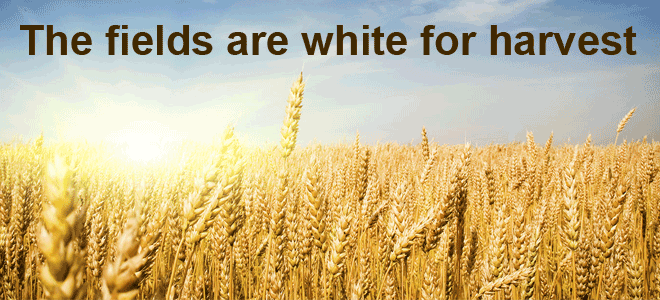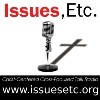 In John 4:25, Jesus said, “The fields are white for harvest,” indicating the urgency of His accomplishing the work of the Father Who sent Him. Not a literal agricultural harvest of wheat or barley bleached and dried by the sun in the sky but a figurative spiritual harvest of souls redeemed by the Son of God presently awaits the Church. That spiritual harvest is the focus of Pentecost and the more than four months of Sundays after Pentecost.
In John 4:25, Jesus said, “The fields are white for harvest,” indicating the urgency of His accomplishing the work of the Father Who sent Him. Not a literal agricultural harvest of wheat or barley bleached and dried by the sun in the sky but a figurative spiritual harvest of souls redeemed by the Son of God presently awaits the Church. That spiritual harvest is the focus of Pentecost and the more than four months of Sundays after Pentecost.
The Old Testament festival of Pentecost, fifty days after Passover, related to a literal agricultural harvest (Leviticus 23:15-21), but the New Testament festival of Pentecost, fifty days after The Resurrection of Our Lord, relates to a figurative spiritual harvest (Acts 2:1-41). As Jesus by way of the Holy Spirit continues to work through the Church’s words and Sacraments, God harvests thousands of souls from the fields of all times and places. This year’s appointed Gospel Reading for Pentecost Day, John 7:37-39, refers to the giving of the Holy spirit to that end.
The First Sunday after Pentecost, called Trinity Sunday, celebrates the richness of the Triune God: Father, Son, and Holy Spirit—three Persons of one divine substance. Within the Trinity, the Father begets the Son, the Son is begotten, and the Holy Spirit proceeds at least from the Father. Outside the Trinity, God’s works generally can be ascribed to any of the three Persons, although only the Son was sent by the Father to take on human flesh and so die and rise in order to save us from our sins by grace through faith that the Holy Spirit creates. This year’s appointed Gospel Reading for The Holy Trinity, Matthew 28:16-20, is one of the most explicit texts for the unity of the divine substance and the plurality of the Divine Persons.
For the rest of the Sundays after Pentecost, the dates and Gospel Readings (according to Lutheran Service Book Series A) are listed below. In this particular Church Year, you may note that one Sunday after Pentecost yields to the Feast of All Saints’ Day. Special midweek observances during the period include Reformation Day, October 31, and a Day of National Thanksgiving, November 27.
• Second Sunday (06/22): Jesus means not fearing persecution (Matthew 10:5a, 21-33)
• Third Sunday (06/29): faith in Jesus divides people (Matthew 10:34-42)
• Fourth Sunday (07/06): Jesus invites all to Him for rest (Matthew 11:25-30)
• Fifth Sunday (07/13): Jesus describes different spiritual soils (Matthew 13:1-9, 18-23)
• Sixth Sunday (07/20): Jesus tells a parable about weeds (Matthew 13:24-30, 36-43)
• Seventh Sunday (07/27): Jesus speaks of His giving all for us (Matthew 13:44-52)
• Eighth Sunday (08/03): Jesus feeds 5,000 (Matthew 14:13-21)
• Ninth Sunday (08/10): Jesus walks on water (Matthew 14:22-33)
• Tenth Sunday (08/17): Jesus answers a plea for mercy (Matthew 15:21-28)
• Eleventh Sunday (08/24): Jesus builds His Church (Matthew 16:13-20)
• Twelfth Sunday (08/31): Jesus calls all to take up their crosses (Matthew 16:21-28)
• Thirteenth Sunday (09/07): Jesus speaks of forgiving one another (Matthew 18:1-20)
• Fourteenth Sunday (09/14): Jesus warns the unforgiving (Matthew 18:21-35)
• Fifteenth Sunday (09/21): Jesus tells a parable about grace (Matthew 20:1-16)
• Sixteenth Sunday (09/28): Jesus’s authority is challenged (Matthew 21:23-27)
• Seventeenth Sunday (10/05): Jesus speaks of His being rejected (Matthew 21:33-46)
• Eighteenth Sunday (10/12): Jesus tells a parable of a wedding (Matthew 22:1-14)
• Nineteenth Sunday (10/19): Jesus says to give God what is His (Matthew 22:15-22)
• Twentieth Sunday (10/26): Jesus stumps those challenging Him (Matthew 22:34-46)
• All Saints’ Day (11/02): Jesus speaks about the blessed ones (Matthew 5:1-12)
• Twenty-second Sunday (11/09): Watch for Jesus’s Kingdom (Matthew 25:1-13)
• Twenty-third Sunday (11/16): Judgment is coming (Matthew 25:14-30)
• Last Sunday of the Church Year (11/23): Faith produces works (Matthew 25:31-46)
Red, white, and green may bring secular Christmas decorations to mind, but, respectively, they are the colors the Church uses for Pentecost, Trinity Sunday, and the Sundays after Pentecost. Red brings to mind the fire of the Holy Spirit and the blood of the martyrs who died bearing His message. White brings to mind joy and glad celebrations, light and purity, and the innocence that is ours by Holy Baptism through which we receive Christ’s righteousness. And, green brings to mind the life and growth evident in foliage and fruit. (Observances of Reformation Day and All Saints’ Day use red and white, respectively.)
Regardless of the season or day, everyone is always invited and welcome in person at Pilgrim Lutheran Church, and you can read and hear any of the sermons preached at Pilgrim here.
The banner graphic at the top of this page uses an image found here, where no information about the origin of the image was provided.

